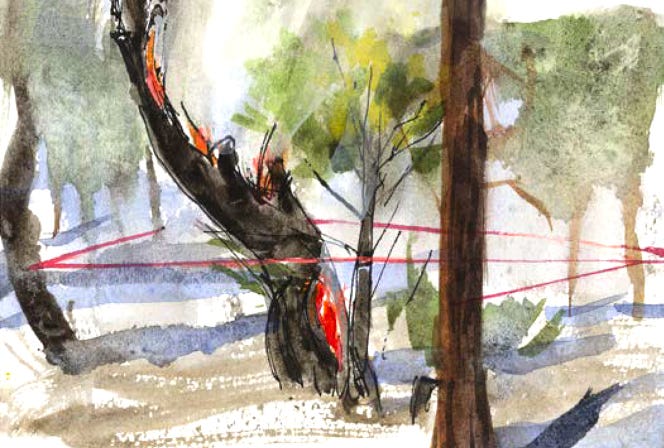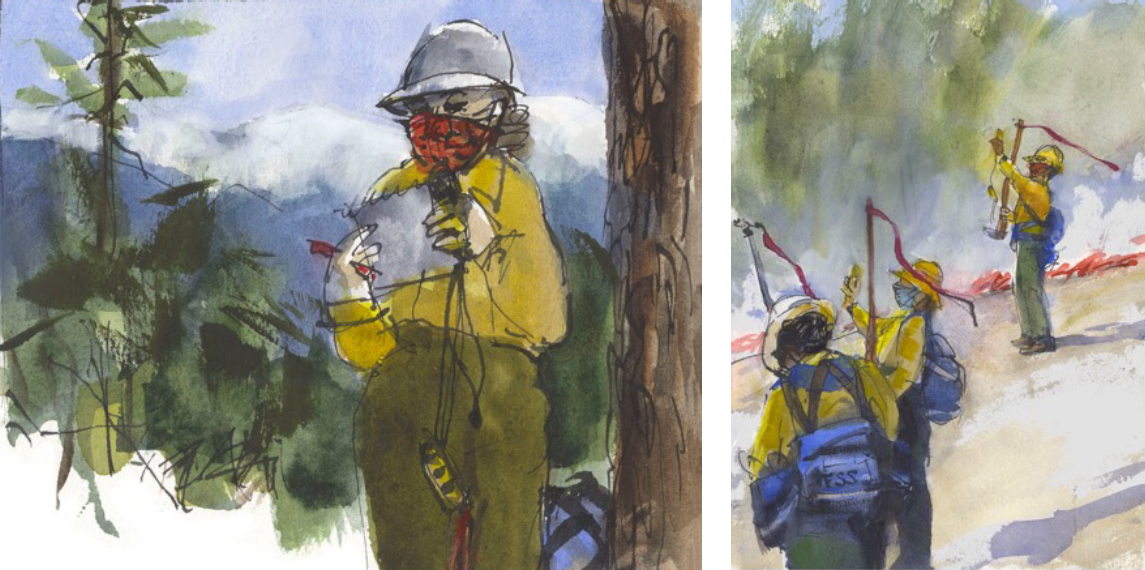Sketching on the streets of San Francisco can sometimes feel like an extreme sport, but it’s nothing like the thrill of sketching in a burning forest, retreating from a line of fire advancing down the hill towards me.

I was in Quincy, at the far northern edge of California’s Sierra Nevada mountains, for a TREX workshop. TREX (Prescribed Fire Training Exchanges) is a national program started by The Nature Conservancy that is teaching non-firefighters how to burn safely to reduce the fuel load in our forests, to prevent or mitigate the huge wildfires that have swept the West in recent years.
This TREX was in March 2021 and Plumas County was working hard to keep their COVID numbers low, so the 50 participants at the opening briefing were wearing masks and trying to stay 6 feet apart. As I listened to everyone shout their introductions across the Feather River College lawn, I was impressed by the wide variety of backgrounds. There were veteran wildfire crew chiefs and student interns; farmers, foresters and scientists—and nearly half the participants were women. There were representatives of the local Mountain Maidu tribe who spoke about the cultural significance of burning—not just to avert modern catastrophic fires but as an ancient tool for land management.

I had been hired by the Plumas County Fire Safe Council to teach nature journaling as a way to develop observational skills for planning burns. I also led a workshop for the community on using art to understand the post-fire landscape. We went sketching at the edge of the burn scar left by the North Complex Fire the previous year, and looked at how the fire had skipped around, burning some areas severely and others hardly at all. We could also see places where previous underburning had stopped the fire or kept the flames from reaching the trees’ crowns. We did drawings of trees on the edge of the burn area, looking at which ones would likely survive, and which were “dead but don’t know it yet”.

By the third day the workshop participants got to practice setting fires. I was done teaching, so I could focus on learning and sketching. We went to the Genesee Valley, an area northeast of Quincy where a local landowner had been doing underburns for years to restore an oak woodland to the way it had been a hundred years ago, before forestry policy dictated the suppression of all wildfire.
I was assigned to follow the trainee FEMO (Fire Effects Monitors) team, as they took readings on temperature, moisture, wind speed and wind direction, to determine if the burn would be within prescription.
If any of the numbers get above the maximum weather parameters for the day, the burn boss can shut it down. It’s all about finding that sweet spot, where the stuff on the ground is moist enough that it doesn’t burn too hot but is dry enough to burn thoroughly. The people doing the burning have to understand the complex interactions of fuels (from from pine needles on the ground to huge old trees), topography (like the way a fire burns hotter going up a hill) and weather (all those things the FEMOs were monitoring) to predict when it’s safe to start a fire.
Starting at the top of the hill and working down, lots of small fires are lit with drip torches, sprinkling a mixture of burning diesel and gasoline. The trick is to put down enough fire to burn up the flammable ground cover, but not so much that it damages the mature trees.

“Ladder fuels” will sometimes carry the fire up a tree, causing it to “torch”. When a tree was torching they would sometimes allow it to burn completely, bringing in water trucks to make sure the fire didn’t spread. I learned to listen for the distinctive crackling, hissing, spitting sound of flames moving fast up a tree, making sure I kept my distance.

There are some unique challenges to this kind of sketching. Usually I sink into the experience of sketching and tune out everything and everyone around me (especially in the city, where people often crowd around to watch me work). But when drawing live fire I had to keep part of my attention on my surroundings at all times.

Another challenge was having to wear protective gear. I’m not a hat person at the best of times, and keeping that hard hat on my head was a trial. I could take off my heavy gloves to sketch, but had to keep them stuffed in a pocket in case I needed to grab a burning branch. Fortunately my old worn-in hiking boots had fire resistant soles, so I was comfortable walking, even on recently-burned areas.
“After spending the day drawing fire I felt like I had developed a new awareness, not just of wind and smoke, but of everything around me. It felt like this kind of connection is the foundation for all the ways that we organize the world around us.”
This small prescribed fire was wrapped up safely, but a few months later the devastating Dixie wildfire would burn through nearly one million acres of land around Quincy, including the area of our practice burn. Researchers have since found that the Dixie fire burned less intensely in areas which had received low intensity fire in the last 35 years—and even less intensely in areas that burned in the last 10 years.1
I think this form of visual journalism is an effective way to inform and educate. A sketch is often easier to understand than a photo because the artist can strip out extraneous detail and direct the viewer’s eye to the important parts. Sketches like these can also explain the principles of “good fire” in a way that’s more fun and engaging than the bare-bones diagrams in instruction manuals. On-the-spot drawings are also a good way to get the word out on social media.
We need to be doing much much more prescribed burning to protect California’s forests from the stresses of climate change—and I’m hoping to spend more time out there sketching that story.
For more illustrated accounts of wildfire and recovery, see Robin Carlson’s book The Cold Canyon Fire Journals: Green Shoots and Silver Linings in the Ashes and Miriam Morrill’s book Pyrosketchology: An Illustrated Guide to Nature Journaling About the Fire Environment (You can download free pdfs of each chapter from the Pyrosketchology website.)
drawings © Laurie Wigham
See more artwork by Laurie Wigham on her website.
Taylor, Harris and Skinner, “Severity patterns of the 2021 Dixie Fire exemplify the need to increase low-severity fire treatments in California's forests”, IOOP Science, Environmnental Research Letters, 21 June, 2022





Great combo of verbal and visual.
These are such gorgeous paintings! The fire looks eerily at home in the natural landscapes - the oranges and reds are like warm fall colours. It reminds me of how it can be kind of hard to see a camp fire during the day. Kind of freaky and humbling! But I’m glad people are doing this work and that we got to see it in this lovely form! 🥰🔥😅